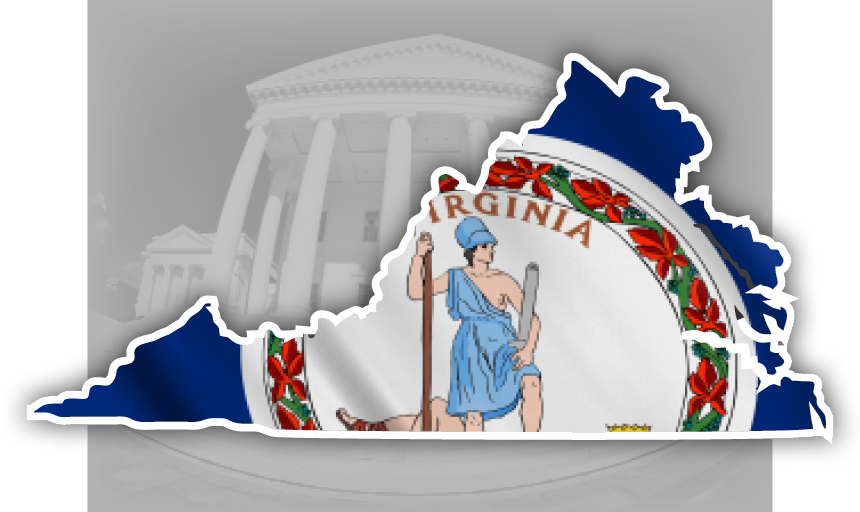Roanoke College Poll: Sentiment is strong with Virginians, although impacted by political unrest
March 06, 2019

The Virginia Index of Consumer Sentiment increased for the second consecutive quarter by almost two points, coming in at 98.7, more than seven points above the 5-year average. The increase is largely due to gains in consumer expectations for the coming year although there is growth in support for current conditions as well. The party gap grew in the reading for 2019 after reaching the highest value since the 2016 presidential election in August 2018.
Figure 1. Virginia Consumer Sentiment, past two years (black=VAICS, blue=5-year historical VAICS average)

Consumer sentiment continues rise into 2019
The Virginia Index of Consumer Sentiment (VAICS) continues its end-of-year jump in 2018, rising 2.1 points in the first quarter of the new year. The national value is 93.8, which increased since January, its worst reading since November 2016. The January slump was attributed to the government shutdown, and the February rebound partially attributed to the reopening of the Federal Government. Figure 2 shows the current index values for Virginia and the U.S.: current, expectations, and overall sentiment, respectively (left to right). Both remain near post-recession highs, in keeping with the positive economic and labor market news, and despite stock market and political volatility, and uncertainty about international policy.
Figure 2. February 2019 Virginia and U.S. Indexes of Current Conditions, Consumer Expectations, and Consumer Sentiment (left to right)

Figure 3 shows the five-year historical values for the VAICS and its two sub-indexes, the Index of Current Conditions (VAICC) and the Index of Consumer Expectations (VAICE). All values increased from last quarter, the VAICE particularly so. The increase stems primarily from optimism about the overall economy and increased incomes compared to a year ago. Over 43% anticipate the next five years to be a period of strong economic growth and prosperity and 42% believe their household finances will improve over the next year. Over 64% believe that now is a good time to buy large durable items due to both rising income and strong deals found in stores or online, continuing the holiday sentiment at the end of 2018.
Figure 3. Five-year historical values for three Virginia indexes


The Roanoke College Poll is funded by Roanoke College as a public service.
Party divide grows amid political unrest in Virginia
Figure 4 shows the Virginia Index of Consumer Sentiment by party affiliation. Prior to the 2016 presidential election, Democrats were considerably more optimistic about the economy than their right-leaning peers. The party gap closed heading into the election, and flipped afterward, hitting a high in the third quarter of 2018 of almost 49 points. After the November 2018 election, Democrat sentiment jumped eight points while Republican’s fell by five points, closing the gap significantly.
February was a tumultuous month for Virginia politics, reflected in the sentiment slide for the two major party affiliations: Democrat and Republican. Those who affiliate with the Democratic Party reduced their sentiment by over four points, while Republicans also showed dissatisfaction with a drop in reported sentiment of more than two points. The overall gains in Commonwealth sentiment are from those who affiliate as Independents or some other party.
Figure 4. Virginia Index of Consumer Sentiment, Democrat and Republican

Note: Lines = Virginia Index of Consumer Sentiment (blue=D, red=R), Dashed Lines = VAICS Historical Average
Inflation expectations fall significantly
Short-term inflation expectations fell from last quarter, coming in at 2.3 percent, close to the lowest level since 2012. Long-term expectations dipped to a historic low of 3.2% as shown in Figure 5. Suggestions of abbreviated rate increases by the Federal Reserve Bank, discussed frequently in the press, are likely driving the expectations. The measures indicate direction of overall price growth anticipated by Virginians over the next year and next 5-10 years, respectively. These expectations are close to their historical averages, suggesting respondents are not concerned with abnormal price growth. Price stability is important for investment and retirement planning.
Figure 5. Short and long-term inflation expectations

Methodology
Interviewing for The Roanoke College Poll was conducted by The Institute for Policy and Opinion Research at Roanoke College in Salem, Va. between February 10 and February 20, 2019. A total of 594 Virginia residents 18 or older were interviewed. Telephone interviews were conducted in English. The random digit dial sample was obtained from Marketing Systems Group and included both Virginia landline and cell phone exchanges so that all cell phone and residential landline telephone numbers, including unlisted numbers from Virginia exchanges, had a known chance of inclusion. Cell phones constituted close to 30 percent of the completed interviews.
Questions answered by the entire sample of 594 consumers are subject to a sampling error of plus or minus approximately 4 points at the 95 percent level of confidence. This means that in 95 out of 100 samples, like the one used here, the results obtained should be no more than 4 points above or below the figure that would be obtained by interviewing all consumers who have a telephone. Where the results of subgroups are reported, the sampling error is higher. Sampling weights were constructed using Virginia Census 2010 data by age, race and gender groups. Quotas were used to ensure that different regions of the Commonwealth were proportionately represented. The margin of error was not adjusted for design effects due to weighting.
A copy of the questions and all toplines may be found here.
For more about the Institute for Public Opinion Research, click here.
Contact Name: Dr. Alice Louise Kassens, Senior Analyst, IPOR
Contact Phone: (540) 375-2428 Office, (540) 816-8830 Cell
Contact Email: kassens@roanoke.edu